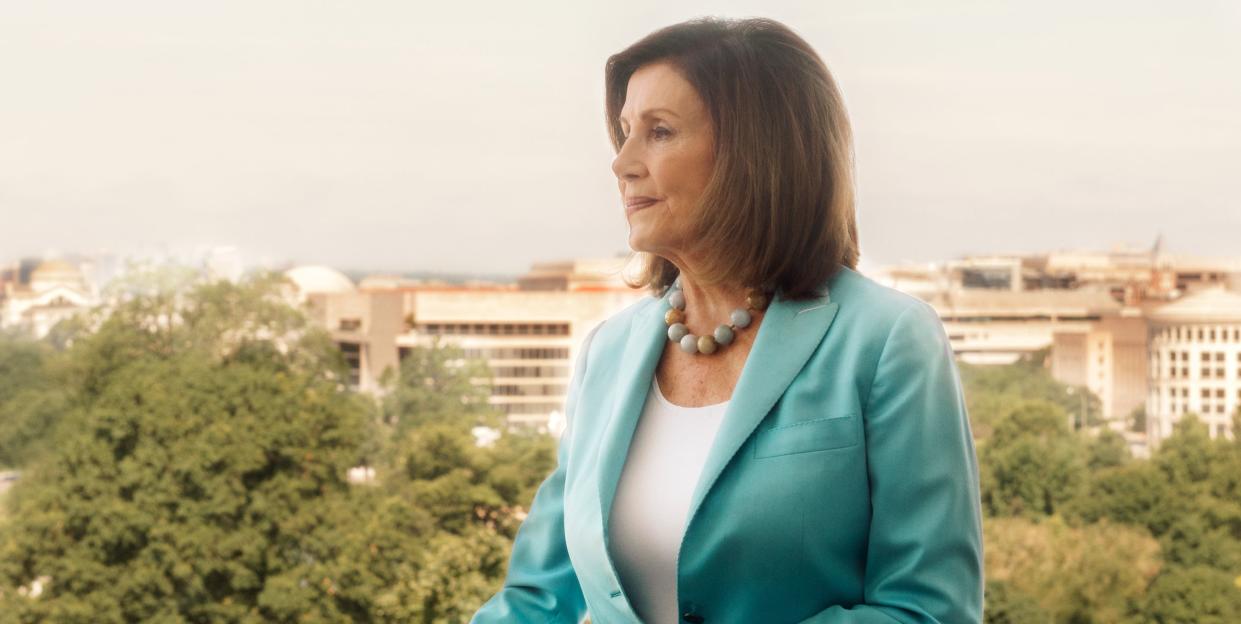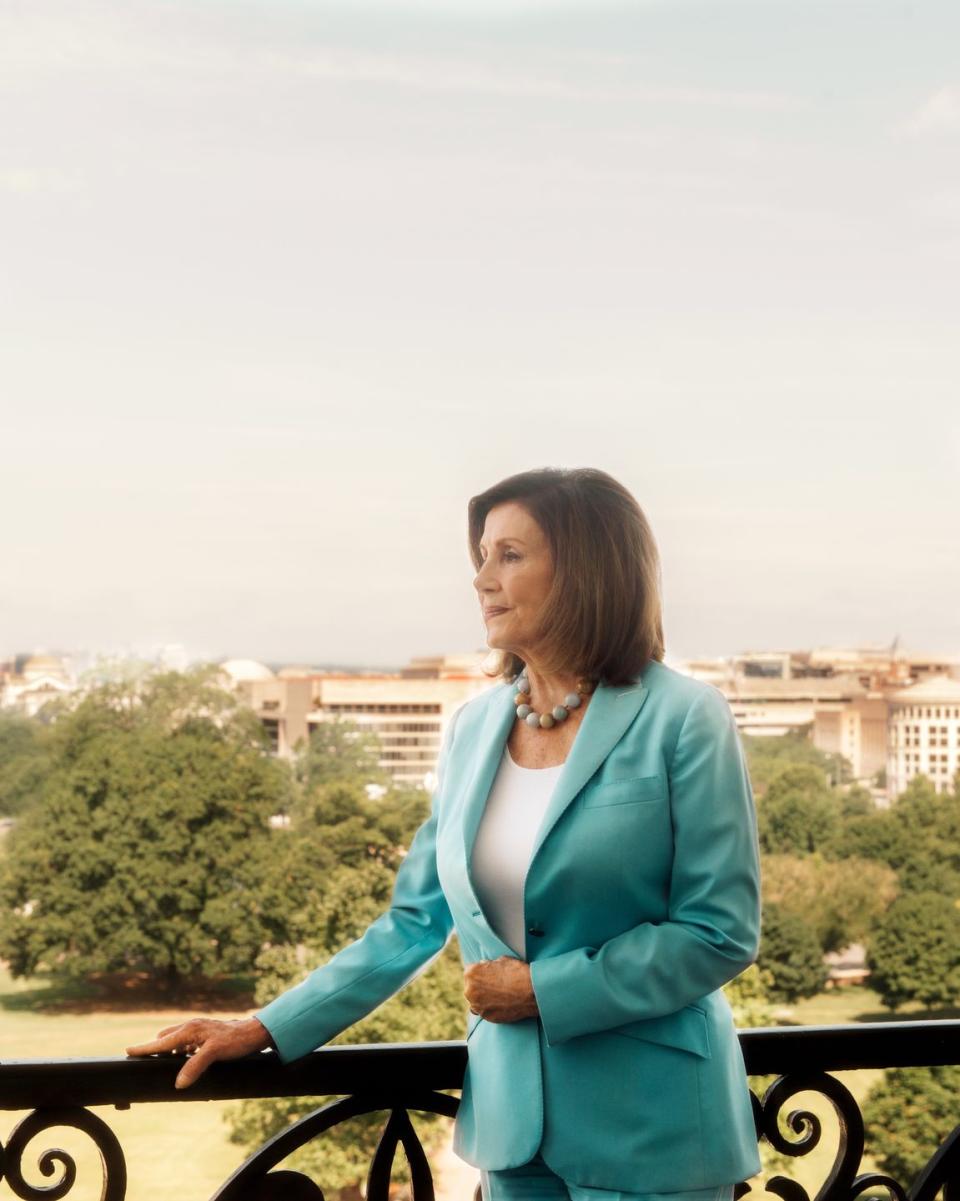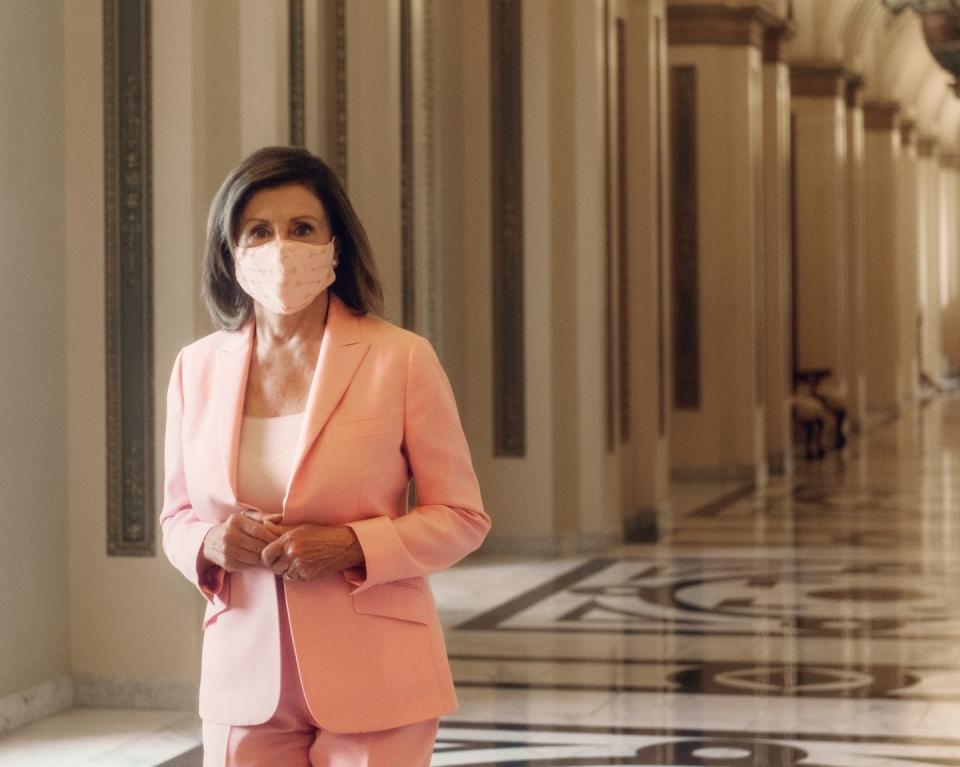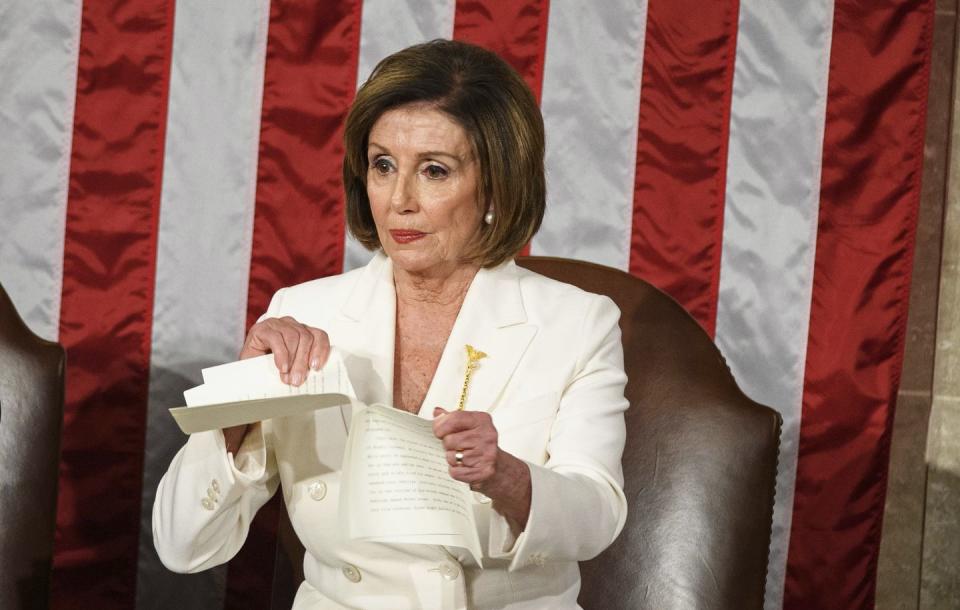Nancy Pelosi Is Trump's Nightmare. She Couldn't Care Less.


It’s a sweltering and stormy Thursday afternoon in June, but the marble halls of the U.S. Capitol are eerily cold and quiet. The coronavirus pandemic has virtually emptied out the grand building, shutting down Capitol tours and confining politicians and staffers to their homes. A few security guards in black COVID masks, practically whispering so their voices don’t echo, have the main floor to themselves. But three stories up, in an elegant cream-and-gold office overlooking the Washington Monument, Nancy Pelosi is still toiling away at her desk. The 80-year-old Speaker of the House, who would normally be out campaigning and fundraising during a congressional recess, is here alone, apart from a handful of staffers, essentially running the country via Zoom.
The situation is unexpected for more reasons than one. Pelosi was not still supposed to be here. She was planning to retire on a high note in 2016 when Hillary Clinton won the presidency, knowing that Pelosi’s proudest accomplishment, the Affordable Care Act, would be in good hands—her legacy preserved. Instead, Pelosi watched from what was intended to be a celebratory election party in DC as Donald Trump, the virulently sexist reality television host who had promised to “repeal and replace Obamacare,” raked in swing state after swing state. “It felt like getting kicked in the back by a mule. Twice,” Pelosi says, jabbing a fist into the air.
So here she is, four years later, having regained control of the House just in time to preside over one of the strangest, darkest years in history. A once-in-a-lifetime global pandemic has killed over 200,000 Americans and dramatically changed life as we knew it for the foreseeable future. Unemployment is soaring; the economy is plunging into a depression. Black Lives Matter protesters are pouring into the streets across the country, demanding changes to the nature of policing. The president is melting down in his White House bunker, picking petty fights on Twitter and lying to the public daily about the health crisis. And Pelosi is, basically, dealing with it all by herself. “I don’t know if people realize that she’s the one leading the government right now,” Representative Karen Bass (D-CA), chair of the Congressional Black Caucus, tells me. “We have an unstable president, we have a Senate leader who has abdicated his responsibility to the unstable president, and then we have a Speaker who’s actually leading.”

I wait for Pelosi at a grand 20-foot table in her personal conference room, staring down her mounted taxidermy bald eagle. The bird’s nickname is Sparky, her aide later tells me, because it died by accidentally flying into an electric wire. Pelosi, a passionate conservationist, is a bit uncomfortable keeping a dead animal in her office, but it was a gift from former Senate Majority Leader Harry Reid when he retired from office. So she mounted it atop an eight-foot pole so at least visiting children couldn’t try to pet it.
When she arrives, we sit awkwardly far away from each other in the pale yellow-striped chairs in her office parlor, with sweeping views of the National Mall, negotiating whether one or both of us should keep our masks on for this interview. I tell her I’m terrified of being the Trojan horse that delivers a deadly contagion to the most powerful woman in America amid several national crises. She laughs and says she’s more concerned about passing the virus to me. It’s a bit difficult to interview a politician from nine feet away in a mask; she references one of her favorite books, The Ascent of Man, and I hear “The Scent of a Man,” which sounds like a very different kind of book. So she pulls her mask down to talk, and I keep mine on.
The Speaker looks like she could be at least a decade younger than she is. She is dressed from head to toe in marigold yellow: Her fitted sheath dress, beaded necklace and bracelet, and four-inch stilettos—even her COVID mask—are all the same shade. It’s a surprisingly joyful ensemble, given the bleakness of the current moment. Days earlier, Pelosi’s own daughter, Alexandra, was pepper-sprayed outside the White House by federal law enforcement agents as they cleared out protesters for the president’s photo op outside a nearby church. “She called me after she had recovered from her visual impairment,” Pelosi says coldly. “She was an eyewitness to it. It was like a banana republic—teargas ’em, get ’em out of the way so the big Humma-Humma can walk through with an upside-down Bible to a church he’s probably never been in.”
Pelosi and Trump are barely on speaking terms, and she very much does not want to talk about him. She has accomplished so much in life as the first female House Speaker in American history, and it annoys her that her legacy is now tangled up in his. “I don’t even think about him, to tell you the truth,” she says. “This is the most conversation I’ve had about him, certainly all day.”
Throughout the pandemic, Pelosi has mostly been negotiating with Treasury Secretary Steven Mnuchin, instead of Trump, to pass relief packages. She managed to get the bills passed through the Republican-controlled Senate, proving she can do it without the president. “Somebody said the other day, ‘Why don’t you go talk to him?’ ” Pelosi says. “And I’m like, ‘I don’t have to undergo that.’ ”
Pelosi is Trump’s greatest foil—the only real check on his power. She’s presided over his impeachment, famously ripped up his speech after his State of the Union address, and insulted his masculinity on cable news. He calls her “Crazy Nancy,” “Nervous Nancy,” and “unhinged”; she doesn’t care. “I have no interest in what he calls people, because he’s always projecting,” she says. “He knows he’s crazy; it’s so self-evident. Everything he calls anybody—‘lazy,’ ‘crazy.’ Quite frankly, I don’t pay that much attention to him. I think it’s really a sad, sick situation.”
Their relationship wasn’t always so contentious. Pelosi says she tried, in the beginning of Trump’s presidency, to negotiate with him in good faith, the way she’s done with other Republican leaders. “I thought, If he cared, I could show him how he could take credit for things. I would say, ‘I won’t ask you to do anything that’s not in your interest, and I think it’s in your interest to do DREAMers,’ ” she says, referring to legislation that would give undocumented children a path to citizenship. “But there’s no truthfulness. He’d say, ‘Yes, we’re gonna do DREAMers.’ Then no, they didn’t. It became a waste of time.”
So Pelosi decided to take charge of things herself. In early 2019, after Democrats took back control of the House in the midterm elections, she adeptly quashed a mini insurgency within her caucus to be elected Speaker again, making her not only the first woman to have ever held the position, but the first person in more than 50 years to hold the office twice. Under her leadership, the House has passed legislation to raise the minimum wage to $15, reform police departments, enhance the Affordable Care Act, and repair bridges and roads as part of a $1.5 trillion infrastructure plan. In just the past few months, it’s passed four COVID relief bills. Pelosi has also blocked funding for Trump’s border wall, thwarting his biggest campaign promise. “She’s the right woman for the right time,” says Representative Barbara Lee (D-CA). “When you look at how she’s been able to shepherd progressive issues through a very diverse caucus, it’s remarkable how she’s able to pull people together.”
The most memorable moment of Pelosi’s tenure under Trump, of course, was when she presided over his impeachment in December 2019. After the vote, she demonstrated her tight control of her caucus with a swift hand gesture on the House floor to silence a few rogue members who celebrated after she’d instructed members to remain somber. The disciplinary, mom-like move made people stiffen up in their chairs. “They just forgot,” she says, laughing. “Sometimes you’re exuberant, you’re so into it. But it was a sad day for our country. There was no cause for celebration.”
After the impeachment, Pelosi says, her relationship with Trump really “deteriorated.” She tore up her copy of his 2020 State of the Union address as soon as he was done speaking, right in front of the cameras. “I didn’t go in there intending to tear it up, and then I heard the constant flow of lies. And we got like a third [of the way] through, and I thought, Should I do it or should I not?... I’m doing it,” she recalls of the now-iconic moment. “Because it was a pack of lies. It dishonored the chamber.”

The next month, COVID struck. As the death toll rose, and senators like Ted Cruz (R-TX) and Mike Lee (R-Utah) self-quarantined, everything changed. Pelosi could no longer visit her grandchildren or meet with members in person. She had to decide whether or not, for the first time in history, to allow House members to vote remotely by proxy, which she eventually did. Everything she has done during the COVID nightmare has been heavily scrutinized. Republicans criticized her for allowing members to vote remotely; Democrats criticized her for waiting too long to do so. In April, during a brief trip home, she filmed a segment of The Late Late Show on CBS from her kitchen in San Francisco, and critics zeroed in on the stash of ice cream in her expensive refrigerator. “I think [the Democrats] should be back here, but they don’t,” Trump told reporters at the time. “They’re enjoying their vacation...if you look at Nancy Pelosi eating ice cream on late-night television. They’re having a good time.”
Pelosi fired back that having ice cream in her freezer is “better than having Lysol in somebody’s lungs,” referring to the president’s press conference when he floated the idea of ingesting household cleaners to fight coronavirus.
Sometimes the critiques are fair; Pelosi should understand, by now, the message it sends to show off her bougie desserts in a restaurant-grade freezer on a comedy show while scores of people are dying and losing their jobs. But sometimes she’s simply a scapegoat for people’s general frustrations with Congress, or politics, or the Democratic Party. The press and the Twittersphere savagely mocked her in June, for instance, for wearing an African kente cloth stole, along with fellow members, to kneel for George Floyd in the Capitol, just before introducing a police reform bill. The kente wasn’t her idea; Bass and the Congressional Black Caucus, whom Pelosi had put in charge of police reform legislation, had requested that all the members wear kente cloths that day in solidarity with Black people. “The president of Ghana gave her that kente. I was there,” Bass says of Pelosi. “The Congressional Black Caucus has been wearing kente for the last several years. And I thought, given the important legislation we were introducing, to focus on whether someone was wearing kente cloth or not was very perplexing.”

Pelosi knows she is as hated as she is admired. For Republicans, she’s the “San Francisco liberal” boogeyman they’re always campaigning against. And for some on the left, she represents an outdated Democratic Party that sides with money and power and thwarts the priorities of its progressive base. Pelosi doesn’t embrace “Medicare for all,” for instance, or the Green New Deal; she only concerns herself with legislation that she thinks can actually pass the House. It took all her political might to squeak health care reform through the House in 2010—even with a Democratic majority in the Senate—so she’s not inclined to take on major policy ideas that are even further to the left while Republicans control the Senate. The Green New Deal “is an aspiration,” she says, “and I encourage that. But we have to be answerable for what we are going to pass into law.”
She’s also been publicly sparring with the progressive freshman members known as the “squad”—Representatives Alexandria Ocasio-Cortez, Ilhan Omar, Ayanna Pressley, and Rashida Tlaib—who feel that she dismisses them. “There hasn’t really been a relationship [with Pelosi], to be frank,” Ocasio-Cortez told the Washington Post in July. “It’s difficult.”
One relatively new progressive member says Pelosi gives preferential treatment to colleagues who, like Pelosi, have been in politics a long time. “That’s where some of the tension comes from,” says the member, who spoke on condition of anonymity. “A lot of us didn’t follow the playbook of how to get to Washington, [or] the playbook of how Washington is supposed to work.”
“People who came out of statehouses may fit more into her idea of how to use and build power,” the member continues. “I stare dead in the eye the fact that the vast majority of Americans think that Congress sucks. I’m often thinking about how important it is to try to reset the American people’s confidence in Congress. And that is very different from some of the things we hear from Speaker Pelosi.”
Pelosi tells me her beef with the squad is overblown; she says she admires the new progressive members and has more in common with them politically than the more conservative Democrats. She’s just got hundreds of other members to lead and major crises to solve. “It’s like, the Speaker is busy doing something else,” she says, noting that it was the same for her when she was first elected to Congress in 1987. “If they said that the Speaker cared what I thought when I came here, I’d be shocked.”
She doesn’t believe it’s her job to be the moral voice of the party. She counts votes, helps Democrats win House seats, and tries to put forth legislation that the vast majority of her members—whether they’re representing the very liberal Bronx or just flipped a Trump district—can support. For instance, Pelosi took heat from progressives earlier this year when she went down to South Texas to campaign for incumbent Representative Henry Cuellar, an antiabortion Democrat, over his more progressive female challenger, Jessica Cisneros. Some cited this as proof that Pelosi’s feminism, or her claim to support abortion rights, was disingenuous. But Pelosi always supports the sitting members of her caucus, and anyway, she thought Cuellar was the more viable candidate. “I’m very definite on the subject of abortion, way out there. Do away with Hyde,” Pelosi says, referring to the long-standing amendment that bans taxpayer dollars from paying for abortions. “But that doesn’t mean I’m gonna lose a House seat because of it.”
This is a frustrating stance for those who want to see Pelosi help drive the party to the left. But even some progressives in her party acknowledge that Pelosi is very talented at her particular job. “Her negotiation skills are masterful,” Katie Porter, a freshman congresswoman, tells me. “And her ability to remember people and their needs. This is someone who’s got a tremendous skill set. I voted for her; she was the right person to vote for in the Trump era. It’s been really beneficial to have seasoned hands leading us.”
Reid, Pelosi’s counterpart in the Senate under President Obama, is such a big fan of Pelosi’s that he literally wears a pin with her face on it. “I would tell those people who are saying she’s not willing to push the envelope: During my time with her, she pushed it big-time,” he says. And she’s a powerful foe for the president. “If you look at Trump and the people he’s afraid of, number one on the list is Nancy Pelosi. She has his number.”
Two weeks after my first interview with Pelosi, I return to DC to see how her daily life has changed as Congress has come back into session. Her press conferences look a lot different than they did before COVID. It’s 10 a.m., and she is standing outside the Capitol in the blazing heat in another exuberant outfit—a hot-pink dress and matching mask, sparkling glitter stilettos, and a rainbow watch for Pride Month—unveiling the Democrats’ new climate plan. Instead of huddling environmental activists behind her in a chaotic mass of people waving signs, they are spread out evenly, exactly six feet apart, across the Capitol steps, like a checkerboard.
The goal of the plan—which Pelosi says should result in over 100 separate pieces of legislation—is to bring the country’s greenhouse gas emissions down to zero by 2050. This is her dream, she says: to be able to pass meaningful climate legislation before she retires. “When I first became Speaker, we did climate the first day,” she says. “Then we were more visionary. Now everybody knows that this has to happen. We’re destroying the planet.”
Pelosi has been under mounting pressure to do something significant about this issue; young protesters, joined by Ocasio-Cortez, stormed her office in late 2018 to demand that she act more decisively on climate change. Pelosi says the issue was one of her earliest passions and intellectual obsessions—before she ran for Congress, she read “every book there is about paleoanthropology” in the bathtub after putting her young children to sleep. “Primates are our relatives,” she reminds me, before launching into a very detailed tangent about the origins of man.
She would love to pass a huge climate bill right now, she says, but the GOP-controlled Senate won’t have anything to do with it. “If you don’t believe in science or governance, then you don’t have to do anything, because you don’t care about what science is telling us is happening to the ozone or the acidification of the oceans,” she says. “So this is perfect for them: no science, no governance, no care about climate.”
There may be a short window coming up for Pelosi to take action. If Democrats take control of the Senate and the White House in 2020, she will have exactly two years to tackle climate change and cement her legacy apart from Donald Trump. She made a deal with her caucus when she ran for Speaker again that she would only stay for four years, so this is it. Her final shot.
Pelosi is literally counting down the days until she gets a chance to work with a different president. “It’s 128 days until he’s gone,” she murmurs at one point. I clarify that she’s referring to Trump. “Yes,” she says, looking at the ticking clock over my shoulder. “And 12 hours.”
You Might Also Like


